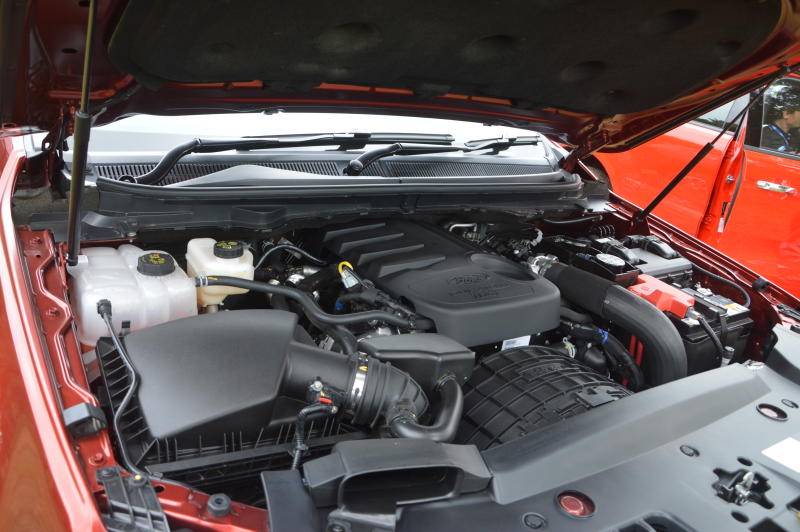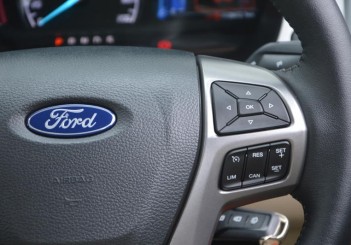We know that sounds too much like advertising copy.
But we can’t help the fact that the 2015 Everest seven-seater SUV really does perform as advertised, as we discovered during a recent 140km media drive in the lush green valleys of Chiang Rai, Thailand.

The American marque’s sales in Asean has grown swiftly in the past few years, and the 2015 Everest is the latest in a Ford vehicle line-up that outshines the competition.
Produced at the AutoAlliance Thailand plant in Rayong, the 2015 Everest is due to be launched in Malaysia by year-end.
High comfort levels
Ford has put a lot of safety, occupant comfort and entertainment kit into the 2015 Everest.

So, it is no slouch in terms of safety features.
For entertainment, it features a first-in-class 10-speaker sound system with an amplifier and integrated subwoofer, as well as Ford’s in-car connectivity solution SYNC 2 and an eight-inch touchscreen display.
With SYNC 2, the car’s entertainment system, climate controls and connected mobile devices can be controlled via voice commands like “Temperature 20 degrees” and “Call John”.

“In developing the Everest, we set very aggressive targets for vehicle refinement,” said Ian Foston, chief programme engineer for the Ford Everest.
According to Foston, the Everest has aerodynamic sails on the wing mirrors that can reduce wind throb by up to 10 decibels when driving with the windows down.
Meanwhile, Active Noise Cancellation (ANC) uses technology similar to that found in noise cancelling headphones.
Three microphones mounted in the cabin’s headliner are used to detect engine noise, and send signals to a ANC control module which continuously generates opposing sound waves that are directed via the Everest’s audio system.

Air-conditioning vents are also integrated into the cabin ceiling for the comfort of rear occupants.
There are also an eight-way powered adjustable driver’s seat and dual-zone automatic climate control.
We had the 2.2-litre variant on a leisurely drive via a 55km mixture of city roads and twisty B-stretches, in the morning leg of the Everest experience.
The vehicle was running on 18-inch alloy wheels and 265/60-sized Bridgestone Dueler H/T tyres.
The electric power-assisted steering with Pull Drift Compensation (PDC) technology provided precision cornering as well as effortless control.
PDC provides steering assistance and adapts the steering response based on road or wind conditions.

For heavy shoppers, there is up to 2,010 litres of cargo space with all the rear seats folded.
Off-road credentials
For the 8km off-road drive near the Canary Natural Resort, we had the top-grade 3.2-litre Everest Titanium+ 4X4 that gets even bigger 20-inch alloy wheels and 265/50 tyres.
This beefy variant also gets extra goodies like HID (high-intensity discharge) projector head lamps with auto leveling, LED daytime running lights, a powered panoramic moonroof, a powered front passenger’s seat, first-in-class powered-fold third-row seating and powered liftgate.

A nifty feature here is Active Park Assist which allows drivers to parallel park hands-free, requiring only accelerating, shifting and braking from the driver – a first in its segment in Thailand.
While the 2.2-litre Duratorq four-cylinder diesel engine had plenty of grunt with 160PS of power and 385Nm of torque, the 3.2-litre Duratorq five-cylinder diesel engine provides more heavy-duty performance with 200PS and 470Nm of torque.
Both engines are mated to a six-speed automatic transmission.
The off-road route was muddy and slippery, due to the wet season and we had to pay particular attention to steering the Everest safely, especially on narrow, slick and twisty hilly trails.
On this sort of unfriendly terrain, the Everest was very much at home as we used the Snow/Mud/Grass mode of the first-in-class Terrain Management System, which also offers Normal, Sand and Rock modes.

Off-roaders would also like the Everest’s active transfer case with Torque on Demand, electronic locking rear differential, a best-in-class water-wading capability of 800mm, and 225mm of ground clearance.
We also checked out the HDC (hill descent control) feature, where we were told to keep our foot off the accelerator and brake pedals and just focus on steering, and controlling the speed of descent on a steep downhill run by pressing the cruise control - speed switches on the steering wheel.
Surrounded by verdant forests and a stunning landscape of greenery, we found ourselves ensconced in comfort and enjoying charts hits from the likes of Charli XCX and Taylor Swift, within a cocoon of Ford technology.

“The new Everest is equally at home in busy urban traffic and off-road environments.
“We think it is an over-achiever,” said Ford Asia Pacific vice-president of product development Trevor Worthington.
It is also only offered in rear-wheel drive and four-wheel drive variants.
“We decided on rear-wheel drive as we want the Everest to keep the promise of Ford’s fun-to-drive DNA,” said Worthington.

































